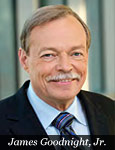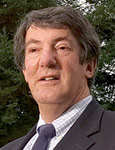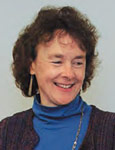First steps: Early leaders paved the way for national prominence

In the early 1980s, he merely wanted
to put together three separate departments— medical oncology, surgical oncology and radiation oncology — that he knew made sense to house in one building.
Breaking ground
James Goodnight Jr. knows that every great journey must start with small steps. In the early 1980s, he merely wanted to put together three separate departments – medical oncology, surgical oncology and radiation oncology – that he knew made sense to house in one building.
"At the time, it was a new idea to put medical and surgical services together," recalls Goodnight, a surgeon who specialized in treating malignant melanoma, breast cancer, pelvic tumors, and bone and soft-tissue cancers. "But cancer care is multidisciplinary in its nature, and it needs to be coordinated."
At the time, UC Davis patients with cancer had a lot of trekking to do to obtain services, according to Goodnight. Not only were medical and surgical oncology in separate buildings, but patients needed to go to the Sutter Medical Clinic on I Street for radiation therapy, as UC Davis did not have its own services.
After years of planning, ground was broken in 1989 for a centrally located cancer center at the UC Davis Medical Center, and the airy building with a two-story, glass-encased lobby opened in 1991, with Goodnight serving as director. Thanks to the large referral network across Northern California developed by Frederick Meyers, a hematologist-oncologist who is now executive associate dean for the UC Davis School of Medicine, patients came flooding in, and haven’t stopped since, according to Goodnight.
Soon the departments of gynecological oncology, pediatric hematology-oncology, urology, and head and neck oncology became associated with the fledgling cancer center as well. The center’s Department of Radiation Oncology, initially run by a rotating chair from UCSF, came under the full auspices of UC Davis in 1995.
"We rapidly became a real center for excellent clinical services," says Goodnight. "At the time, the beautiful building was the shining star of the campus."
Goodnight recognized that what was needed next to eventually realize National Cancer Institute (NCI) designation was a stronger scientific research arm. In 1995, he passed the directorship to Ralph de Vere White, professor of urology, who was already well respected for his research in prostate and other urological cancers. de Vere White assembled a research team, and NCI Cancer Center designation became a reality in 2002.
Goodnight went on to chair the Department of Surgery for 12 years and is currently associate dean for Clinical Affairs and the director of the Practice Management Board, for which he designs the structure, responsibilities and physician medical practice goals for UC Davis.
He remembers with fondness the early days of the cancer center, which he established as a broad, multidisciplinary oncology practice serving the needs of Sacramento and the Northern California region.
"I couldn’t be more proud that the cancer center has now achieved NCI comprehensive cancer center status," Goodnight says. "It is a tribute to the hard work of many individuals over the years and the strong support of UC Davis."
Turning swords into treatments

"Bringing Lawrence Livermore National Lab and the cancer center together was a natural fit, and has resulted in extremely fruitful and exciting work."
Lawrence Livermore National Laboratory and UC Davis Comprehensive Cancer Center collaborations advance cancer research
Jim Felton and Dennis Matthews well remember when a group of UC Davis leaders visited Lawrence Livermore National Laboratory (LLNL) about 15 years ago. de Vere White and a group of department chairs from the UC Davis School of Medicine went on an exploratory mission to see if collaboration between UC Davis and the "weapons lab" would be possible.
At that time, Matthews, a physicist who led LLNL’s medical technology program, and Felton, leader of the lab’s molecular and structural biology division, both oversaw highly innovative, technologically sophisticated research and developed projects conducted by some of the brightest bioengineers in the country.

One of his missions was to make technology available to the cancer center – both through collaborations with LLNL and by bringing appropriate technology to the campus itself.
"We had extremely advanced technological capability, but no patients or physicians," Felton recalls. "Without all those components, you really can’t take research to the level of clinical application."
Meanwhile, UC Davis had patients, doctors and scientists, but not many of the advanced technological tools needed to attain the highest level of research. Few facilities outside of national security laboratories like LLNL did. Both sides at that meeting realized that collaboration offered the potential to achieve much more than either institution could on its own.
"Lawrence Livermore and UC Davis scientists already knew each other from professional meetings, but we couldn’t collaborate until we crafted this alliance," remembers Matthews. "This was truly a win-win arrangement."
A unique research partnership was formed – the largest of its kind in the country – and was a deciding factor in the cancer center earning designation by the National Cancer Institute in 2002.
A high-tech approach to drug development
Felton simultaneously became the deputy associate director for biology and biotechnology at LLNL, as well as the associate director for cancer control at the UC Davis Cancer Center. In those roles, he worked to promote research between scientists at the two institutions, aiming defense technologies against a disease that is one of the nation’s biggest enemies.
Some particularly fruitful collaborative efforts made use of LLNL’s accelerator mass spectrometer (AMS), a large complex machine consisting of a particle accelerator and high-powered magnets available to few cancer researchers worldwide. More commonly used for radiocarbon dating, AMS is so powerful that it can detect the effects of a drug or other chemical down to a dose of only a few hundred molecules.
A new drug development concept – known as human microdosing – evolved from this work, which has since become extremely important to the pharmaceutical industry. The AMS can analyze cellular responses to candidate drugs using much lower doses than are used in conventional research. This provides important information for preclinical drug trials and allows for testing many more candidate drugs at a lower cost, without producing side effects on human volunteers.
Aiming weapons at cancer cells
Although still affiliated with LLNL, Matthews became the associate director for biomedical technology for the integrated program at UC Davis Cancer Center. One of his missions was to make technology available to the cancer center – both through collaborations with LLNL and by bringing appropriate technology to the campus itself.
The center is focused on using light technologies to improve human health, and has conducted many research collaborations in pediatric and adult oncology.
Matthews and his colleagues received National Science Foundation funding for the Center for Biophotonics Science and Technology (CBST) at UC Davis in 2002, and Matthews has served as its director and the grant’s principal investigator since then. The center is focused on using light technologies to improve human health, and has conducted many research collaborations in pediatric and adult oncology.
One of the most exciting team efforts has been the development of a compact proton accelerator for radiation therapy, which could be particularly helpful for pediatric cancers as well as for adult cancers (like prostate cancer) that involve targets close to other critical structures. High-energy proton beams can be focused more accurately than standard X-rays to precisely target cancer cells, leaving more of the surrounding healthy tissue unharmed.
But because of the immense size and high cost of a standard proton accelerator, such therapy is only currently available in about 30 centers around the world.
"A standard proton accelerator needs a football stadium-sized facility to house it and is exorbitantly expensive," says Matthews. "Our charge was to make the cost and size practical for hospitals."
Researchers from LLNL and the cancer center worked together with industry, and the first prototype was recently unveiled. The machine, expected to come to market soon for about $20 million, can fit into a standard radiation therapy vault.
Recalling the old days leading researchers at LLNL, Matthews laughs. "We steered clear of cancer research − it was too hard!" he says. "Now look where we are, thanks to collaboration with the clinicians and cancer researchers at the UC Davis Comprehensive Cancer Center."
Felton agrees. "Bringing Lawrence Livermore National Lab and the cancer center together was a natural fit, and has resulted in extremely fruitful and exciting work," he says. "Obtaining designation now as a comprehensive cancer center is a well-deserved recognition, and a large part of it is because of its far-reaching capabilities in cancer research."
Working together to achieve excellence

"Collaborations are an incredible strength of UC Davis and have allowed the cancer center to flourish. Access to diverse expertise and resources from the vet school, medical school, Primate Center, and the university’s colleges of biological sciences, agriculture and engineering creates an enormously rich environment."
Hsing-Jien Kung and Kathryn Radke see collaboration as key to success of cancer center research
Kathryn Radke, professor emeritus in the UC Davis Department of Animal Science, remembers wondering how she could get access to a flow cytometer for a graduate student. It was the mid-1990s, and a flow cytometer – used for sorting and quantifying microscopic particles such as cells and chromosomes – was not a basic bench-top machine.
Radke’s search coincided with a dream of cancer center director de Vere White’s to establish "shared resources" so that researchers from all over campus could access equipment too expensive to purchase or maintain individually. de Vere White asked Radke to co-chair the effort.
"The idea of a shared resource was a political hot potato because some investigators were already invested in equipment," remembered Radke. "It had to be done without running over anyone’s toes, and since I was outside the medical and veterinary schools, I was viewed as a neutral party."
With the help of Paul Luciw, professor of pathology and laboratory medicine, who wrote a shared instrumentation grant for a state-of-the-art cell flow cytometer, the first shared resource at UC Davis was born.
de Vere White gave Radke, known for her research on cancer-causing viruses, another assignment: join the search committee for someone to lead the cancer center’s expansion of basic science research.

"We know how to work together, and that is one of the secrets to our success. We have a dream team."
Radke sought Hsing-Jien Kung, the founding director of basic science at the cancer center at Case Western Reserve University, who had a stellar research reputation.
"Kathryn and Paul convinced me that UC Davis had all the components to become an NCI-designated center," remembers Kung, now deputy director of UC Davis Comprehensive Cancer Center as well as distinguished professor of biochemistry and molecular medicine. "It was clear that there was visionary leadership backed by full support from the university."
Kung arrived in 1998, when only five or six labs were dedicated to cancer research at the Sacramento campus. His initial goal was to establish a cancer research unit at the cancer center that would act as a nucleus to attract other researchers throughout the campus and beyond.
He set a goal of five years for achieving NCI designation as a cancer center. First, he recruited outstanding researchers like Hongwu Chen, Kermit Carraway, Colleen Sweeney and others. Productive research programs were established focused on basic science, clinical translation, epidemiology and bioengineering. Subsequent NCI review panel rankings of the basic science program consistently ranged from outstanding to excellent, according to Kung, and NCI designation was achieved two years ahead of schedule.
The cancer center currently has nearly 50 affiliated labs at the Sacramento campus working on cancer research. Kung also coordinates more cancer research groups at the UC Davis main campus in Davis and the Lawrence Livermore National Laboratory in Livermore.
Kung himself has made significant contributions to understanding the role of cancer-causing oncogenes and growth factors and has earned a reputation as one of the most brilliant scientists at work on cancer. His research is especially important to understanding the development of prostate cancer.
Kung has used his leadership to emphasize "translational research" at the cancer center, encouraging a rapid progression from basic scientific discovery to real-world applications. UC Davis investigators have been on the forefront of discoveries and instrumental in developing novel drugs and their applications for leukemia, lymphoma, breast, brain and ovarian cancers.
UC Davis Comprehensive Cancer Center shared resources, for which Radke paved the way with a single flow cytometry machine nearly 15 years ago, has also grown exponentially, providing member scientists with resources and expertise necessary to conduct leading-edge science. Researchers now have support in nine key areas: animal imaging, biorepository, biostatistics, clinical and molecular pharmacology, clinical trials support unit, genomics, mouse biology, flow cytometry and combinatorial chemistry.
"Collaborations are an incredible strength of UC Davis and have allowed the cancer center to flourish," says Radke. "Access to diverse expertise and resources from the vet school, medical school, Primate Center, and the university’s colleges of biological sciences, agriculture and engineering creates an enormously rich environment."
Kung agrees. He feels that the UC Davis Comprehensive Cancer Center has a relatively small operating budget compared with very large institutions, but others recognize that UC Davis "has always done more with less."
"We know how to work together, and that is one of the secrets to our success," says Kung, proudly. "We have a dream team."
Taking the long view

"It is important to view achieving Comprehensive Cancer Center status as a milestone in a long journey. There is still much work to be done."
David Gandara sees Comprehensive Cancer Center designation – and successes in cancer therapy – as steps in a journey
David R. Gandara came to the cancer center in 1992 as the associate director of clinical research and played an important role in helping UC Davis attain National Cancer Institute (NCI) designation as a comprehensive cancer center. But reaching the highest designation possible from the NCI is not, according to Gandara, the final goal.
Gandara, who currently serves as senior advisor to the director of the UC Davis Comprehensive Cancer Center and director of thoracic oncology, thinks in terms of steps of steady improvement: when the center received NCI designation as a cancer center in 2002, it joined the ranks of 61 in the nation; now as a comprehensive cancer center, it is one of 41. Gandara already is looking to the next milestone: he has recently received an N01 grant from the National Institutes of Health to develop new cancer treatments, one of only seven funded.
"UC Davis is on the pathway to becoming one of the elite cancer centers in the nation," says Gandara. "This is quite an accomplishment for a center of our relatively small size."
Gandara attributes the UC Davis Comprehensive Cancer Center’s strength to the quality of its collaborations. Not only is there exceptional teamwork within the university, but external partnerships put it in a position available otherwise only to the largest medical centers. In addition to the productive association with the LLNL, Gandara singles out the more recent affiliation with The Jackson Laboratory, which opened a site in Sacramento at the old McClellan Air Force Base in 2009.
The Jackson Laboratory, an NCI-designated cancer center for research, specializes in developing strains of genetically defined mice for use in preventing and treating human cancers. Gandara has worked closely with the lab to advance development of preclinical models to optimize cancer drug development and speed the transition to personalized cancer therapy.
As a specialist in lung cancer, Gandara is constantly confronted with an often-fatal disease that frequently responds in unpredictable ways to available and experimental therapies. He leads a program in which patients’ tumors are transplanted into The Jackson Laboratory immunodeficient mice, which then develop each patient’s unique cancer. When the cancer grows in the mouse, it can then be transferred to other mice, so that a whole population of mice can subsequently be tested with different drug therapies to determine the optimum treatment against the patient’s specific cancer.
"We obviously can’t test 10 alternative promising therapies in a single patient, but we can in 10 mice," says Gandara. "We are very hopeful that this technique will help hasten the development of personalized medicine."
Gandara, who is regarded as one of the world’s thought leaders in lung cancer research, has big dreams – he foresees a day when a patient will give her pharmacist a genetic profile of her cancer and get a specific drug to target it.
But he is also a systematic investigator. He knows that curing one patient in a new way is just a step toward the goal of finding better ways to battle the disease. Likewise, he is not ready to rest on the laurels of the new NCI designation.
"It is important to view achieving comprehensive cancer center status as a milestone in a long journey," says Gandara. "There is still much work to be done."






